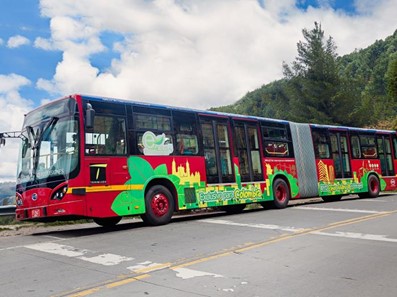- Country: Colombia
- Sector: Buses
- Area of Action: Urban transport
- Type of service: Private initiative
- Power source: Electric
- Aspects described in the case study:
- Technical features of e-buses and actual developments
- Charging infrastructure construction and operation
- Digital solutions assisting the use and operation of e-buses
- Training of e-bus drivers
- Training of e-bus maintenance staff
- Eco driving
- Health and business environment of e-bus driving
CONTEXT
The TransMilenio BTR (Bus Rapid Transit) Corridors represent an advanced example of technical deployment in urban transportation, specifically designed for Bogota, Colombia. Bogota, a large and densely populated city, faces significant challenges such as traffic congestion and air pollution, making it necessary to implement sustainable mobility solutions.
The TransMilenio BTR Corridors involve the electrification of bus transportation on key routes in Bogota. This initiative is a full deployment, not just a pilot test, with the aim of reducing carbon emissions and improving air quality throughout the city. The decision to migrate to electric buses is aligned with Bogotá’s sustainability goals, addressing the impacts of climate change and improving the quality of life of its inhabitants.
By implementing the TransMilenio BTR Corridors, Bogota sets an example for other global cities, demonstrating the feasibility and benefits of integrating electric buses. This initiative reflects Bogota’s proactive approach to sustainable urban development, using innovative transportation solutions to address environmental and social challenges.

THE PROCESS
- Planning and Investment: According to information from the Mayor’s Office of Bogota, a significant investment in the acquisition of electric buses and charging infrastructure was planned, amounting to approximately 60 million Colombian pesos.
- Infrastructure Development: Implementation included the installation of fast charging points in stations and workshops, facilitating the technological integration necessary for an efficient and sustainable fleet. Additional details are available in the technical reports of the Secretariat of Mobility of Bogota.
- Technological Integration: The Mobility Secretariat has implemented advanced technologies for the management and operation of the TransMilenio BTR Corridors, ensuring the efficiency and responsiveness of the transportation system.
- Training Programs: Extensive training programs were carried out for drivers and maintenance personnel. More information on these programs can be found in the sustainability reports published by the Secretariat of Mobility.
- Awareness Campaigns: The Mayor’s Office of Bogota has promoted public awareness campaigns to educate citizens about the environmental benefits of electrification of public transport and encourage responsible use of resources. Additional information is available in press releases issued by the Mayor’s Office.

IMPACT
- Environmental Benefits: According to data from Bogotá’s Secretariat of the Environment, the transition has significantly reduced emissions of polluting gases and improved air quality, benefiting public health.
- Operational Efficiency: There has been a notable improvement in the operational efficiency of the public transportation system, with cost reductions and improvements in the punctuality and reliability of the service, according to TransMilenio reports.
- Public Health: Public health reports indicate a decrease in respiratory problems and other adverse effects associated with poor air quality in areas served by the TransMilenio BTR Corridors.
- Economic Growth: Investment in clean technology has stimulated the growth of the local electromobility sector and created employment opportunities in areas related to electric vehicle technology and maintenance, according to economic data published by the Mayor’s Office.
- Training and Skills Development: Training programs have strengthened staff skills and knowledge, contributing to Bogotá’s leadership in the adoption of sustainable urban mobility solutions.
MORE INFORMATION
During the case study research on the TransMilenio BTR Corridors in Bogota, the city’s commitment to sustainable mobility policies has been observed, highlighted by the progressive implementation of infrastructure and technologies to reduce emissions and improve air quality. Despite the associated technical and management challenges, collaboration between government entities, the private sector and the community has been crucial to overcome barriers and advance the electrification of public transport. In addition, training and awareness initiatives have played a key role not only in the efficient operation of electric buses, but also in community acceptance and support for these solutions. This comprehensive approach has not only generated tangible environmental benefits, but has also stimulated local economic growth, strengthening Bogota’s leadership in the adoption of innovative practices for more sustainable urban mobility.

MULTIMEDIA
Sources: https://www.portafolio.co/files/article_multimedia/uploads/2017/04/18/58f62e4e7d89b.jpeg
https://i.ytimg.com/vi/ftMXkparsG0/maxresdefault.jpg
Videos:
Relevant links:
Social Media:
